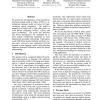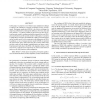66 search results - page 2 / 14 » Adapting acoustic and lexical models to dysarthric speech |
ICMI
2005
Springer
13 years 9 months ago
2005
Springer
Situated, spontaneous speech may be ambiguous along acoustic, lexical, grammatical and semantic dimensions. To understand such a seemingly difficult signal, we propose to model th...
ICASSP
2009
IEEE
13 years 11 months ago
2009
IEEE
We study key issues related to multilingual acoustic modeling for automatic speech recognition (ASR) through a series of large-scale ASR experiments. Our study explores shared str...
ACL
2004
13 years 5 months ago
2004
We present the first application of the head-driven statistical parsing model of Collins (1999) as a simultaneous language model and parser for largevocabulary speech recognition....
ICASSP
2009
IEEE
13 years 11 months ago
2009
IEEE
In this paper, we introduce a new histogram equalizationbased environmental model adaptation method for robust speech recognition in noise environments. The proposed method adapts...
ICASSP
2011
IEEE
12 years 8 months ago
2011
IEEE
In this paper, we propose a novel feature space adaptation technique to improve the robustness of speech recognition in noisy environments. Histogram equalization (HEQ) is an effe...


